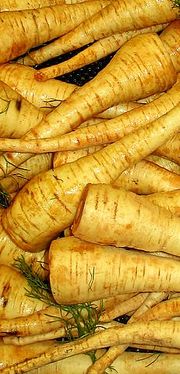Parsnip
| Parsnip | |
|---|---|
 |
|
| Parsnips | |
| Scientific classification | |
| Kingdom: | Plantae |
| (unranked): | Angiosperms |
| (unranked): | Eudicots |
| (unranked): | Asterids |
| Order: | Apiales |
| Family: | Apiaceae |
| Genus: | Pastinaca |
| Species: | P. sativa |
| Binomial name | |
| Pastinaca sativa L.[1] |
|
The parsnip (Pastinaca sativa) is a root vegetable related to the carrot. Parsnips resemble carrots, but are paler than most carrots and have a stronger flavor. Like carrots, parsnips are native to Eurasia and have been eaten there since ancient times. Zohary and Hopf note that the archeological evidence for the cultivation of the parsnip is “still rather limited,” and that Greek and Roman literary sources are a major source about its early use, but warn "there are some difficulties in distinguishing between parsnip and carrot (which, in Roman times, were white or purple) in classical writings since both vegetables seem to have been sometimes called pastinaca yet each vegetable appears to be well under cultivation in Roman times."[2] As pastinache comuni the "common" pastinaca figures in the long list of comestibles enjoyed by the Milanese given by Bonvesin de la Riva in his "Marvels of Milan" (1288).[3]
Contents |
Uses
Until the potato arrived from the New World, its place in dishes was occupied by the parsnip and other root vegetables such as the turnip. While parsnips can be eaten raw, they are more commonly served cooked. Parsnips can be boiled, roasted or used in stews, soups and casseroles. In some cases, the parsnip is boiled and the solid portions are removed from the soup or stew, leaving behind a more subtle flavor than the whole root and contributing starch to thicken the dish. Roasted parsnip is considered an essential part of Christmas dinner in some parts of the English-speaking world and frequently features in the traditional Sunday Roast. Parsnips can also be fried.
The parsnip originates in the Mediterranean region and originally was the size of a baby carrot when fully grown. When the Roman Empire expanded north through Europe, the Romans brought the parsnip with them. They found that the parsnip grew bigger the farther north they went.
Etymology
While folk etymology sometimes assumes the name is a portmanteau of parsley and turnip, it actually comes from Middle English pasnepe, alteration (influenced by nep, turnip) of Old French pasnaie (now panais) from Latin pastinum, a kind of fork, whose ending was changed to -nip by analogy with turnip because it was assumed to be a kind of turnip. It is among the closest relatives of parsley, which can be bred to develop a very parsnip-like root.
Cultivation
Parsnips are not grown in warm climates, since frost is necessary to develop their flavor.. The parsnip is a favorite with gardeners in areas with short growing seasons. Sandy, loamy soil is preferred; silty, clay, and rocky soils are unsuitable as they produce short, forked roots.
Seeds can be planted in early spring, as soon as the ground can be worked. Harvesting can begin in late fall after the first frost, and continue through winter until the ground freezes over.
More than almost any other vegetable seed, parsnip seed significantly deteriorates in viability if stored for long, so it is advisable to use fresh seed each year.
In Roman times, parsnips were believed to be an aphrodisiac.
In the United States, this plant was introduced fairly early in history by British colonists as a root vegetable. In the mid-19th century, it was replaced in popularity by the potato and consequently escaped from cultivation. Today, most states have wild parsnip on their list of noxious weeds or invasive species, especially because wild parsnip contains a chemical which can cause severe skin burns.[4]
Parsnip is used as a food plant by the larvae of some Lepidoptera species, including its namesake, the Parsnip swallowtail and also the Common Swift, Garden Dart, and Ghost Moth.
Nutritional properties
The parsnip is richer in vitamins and minerals than its close relative, the carrot. It is particularly rich in potassium with 600 mg per 100 g. The parsnip is also a good source of dietary fiber. 100 g of parsnip contains 55 Calories (230 kJ) of energy.
References
- ↑ "Pastinaca sativa information from NPGS/GRIN". www.ars-grin.gov. http://www.ars-grin.gov/cgi-bin/npgs/html/taxon.pl?27018. Retrieved 2008-03-02.
- ↑ Daniel Zohary and Maria Hopf, Domestication of plants in the Old World, third edition (Oxford: University Press, 2000), p. 203
- ↑ Noted by John Dickie, Delizia! The Epic History of Italians and Their Food (New York, 2008), p. 38 (where they are identified as parsnips).
- ↑ "Weed watch: Wild parsnip and poison hemlock", Kristine Schaefer http://www.ipm.iastate.edu/ipm/icm/2007/7-9/poison.html
- Dr D.G. Hessayon (2003) The Vegetable & Herb Expert. Expert Books. ISBN 0-903505-46-0
- Dr. Mary Robson (1999) Poison Hemlock : Dangerous to People and Animals". Washington State University Online Directory
- Adam Hart-Davis (2001) What did the Romans do for us?. BBC TV
External links
General
- Pastinaca sativa profile on the USDA plants database
- Pastinaca sativa profile on missouriplants.com
- Pastinaca sativa List of Chemicals (Dr. Duke's)
 This article incorporates text from a publication now in the public domain: Chisholm, Hugh, ed (1911). Encyclopædia Britannica (Eleventh ed.). Cambridge University Press.
This article incorporates text from a publication now in the public domain: Chisholm, Hugh, ed (1911). Encyclopædia Britannica (Eleventh ed.). Cambridge University Press.
Recipes
- Recipes with parsnips at the Open Directory Project
- Parsnip Recipes
- Parsnip Recipe Index
- Recipes and cooking instructions
- Lu's Recipe Extravaganza, Pondering Parsnips?
- Curried Parsnip and Apple soup
- Fried parsnips
- Candied Parsnips
|
|||||